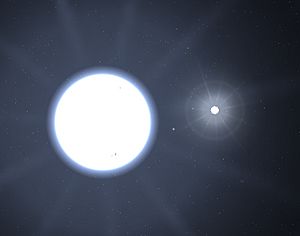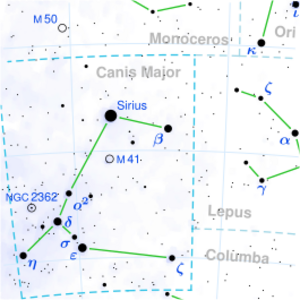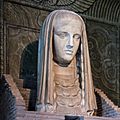Sirius facts for kids

Sirius is the brightest star you can see in the night sky. It is a binary star system, which means it's made of two stars orbiting each other. Sirius is found in the Canis Major constellation, also known as the Great Dog. It's located close to the famous Orion constellation.
Sirius looks so bright because it gives off a lot of light and is also quite close to Earth. It's one of Earth's closest star neighbors, about 8.6 light-years away. The Sirius star system is very old, between 200 and 300 million years old.
Ancient Egyptians called this star 'Sopdet'. They used it to predict when the yearly flood season of the Nile River would begin. Sirius is often called the Dog Star. You might have heard the phrase the dog days of summer. This refers to the hottest days of summer, when Sirius is visible in the sky.
Contents
What is Sirius A?
Sirius A is the main star in the system. It is about twice as big as our Sun. It shines 25 times brighter than the Sun! Even though it's very bright, other stars like Canopus or Rigel are even more luminous.
What is Sirius B?
Sirius B is the smaller star in the system. Long ago, it was much bigger, about five times the mass of the Sun. It was a bright, bluish star.
Over time, Sirius B used up its fuel. It then grew into a red giant star. After that, it lost its outer layers and shrank. About 120 million years ago, it became a white dwarf. A white dwarf is a very dense, small star. Now, Sirius B has about the same mass as our Sun, but it's much smaller, about the size of Earth.
Sirius in Our World
Sirius is a famous star, and its name has been used in many places:
- It's on the symbol of Macquarie University in Australia.
- Several ships of the Royal Navy have been named HMS Sirius. The first one was important for taking settlers to Australia in 1788.
- The Royal Australian Navy also named a ship HMAS Sirius.
- An American plane, the Lockheed Sirius, was named after the star. Charles Lindbergh flew the first one.
- Mitsubishi Motors named an engine the Mitsubishi Sirius engine in 1980.
- The company that runs satellite radio in North America changed its name to Sirius Satellite Radio in 1999. They chose the name because Sirius is the brightest star.
- Sirius is one of the 27 stars on the flag of Brazil. It stands for the state of Mato Grosso.
The composer Karlheinz Stockhausen wrote a music piece called Sirius. He even said he came from a planet in the Sirius system! For Stockhausen, Sirius was a place where music was perfect and had the highest vibrations.
Sirius has also appeared in poetry:
- Famous poets like Dante and John Milton wrote about it.
- Walt Whitman mentioned it in his poem "When Lilacs Last in the Dooryard Bloom'd".
- Tennyson described how Sirius twinkles in his poem The Princess:
...the fiery Sirius alters hue
And bickers into red and emerald.
Related pages
Images for kids
-
Hubble Space Telescope image of Sirius A and Sirius B. The white dwarf (Sirius B) is at the lower left. The spikes and rings are from the telescope itself.
-
Sirius (bottom) and the constellation Orion (right). These stars, along with Betelgeuse (top right) and Procyon (top left), form the Winter Triangle.
-
An X-ray image of the Sirius system from the Chandra X-ray Observatory. The bright spot is Sirius B.
-
A statue of Sopdet, the Egyptian goddess linked to Sirius and the Nile River's fertility.
See also
 In Spanish: Sirio para niños
In Spanish: Sirio para niños










